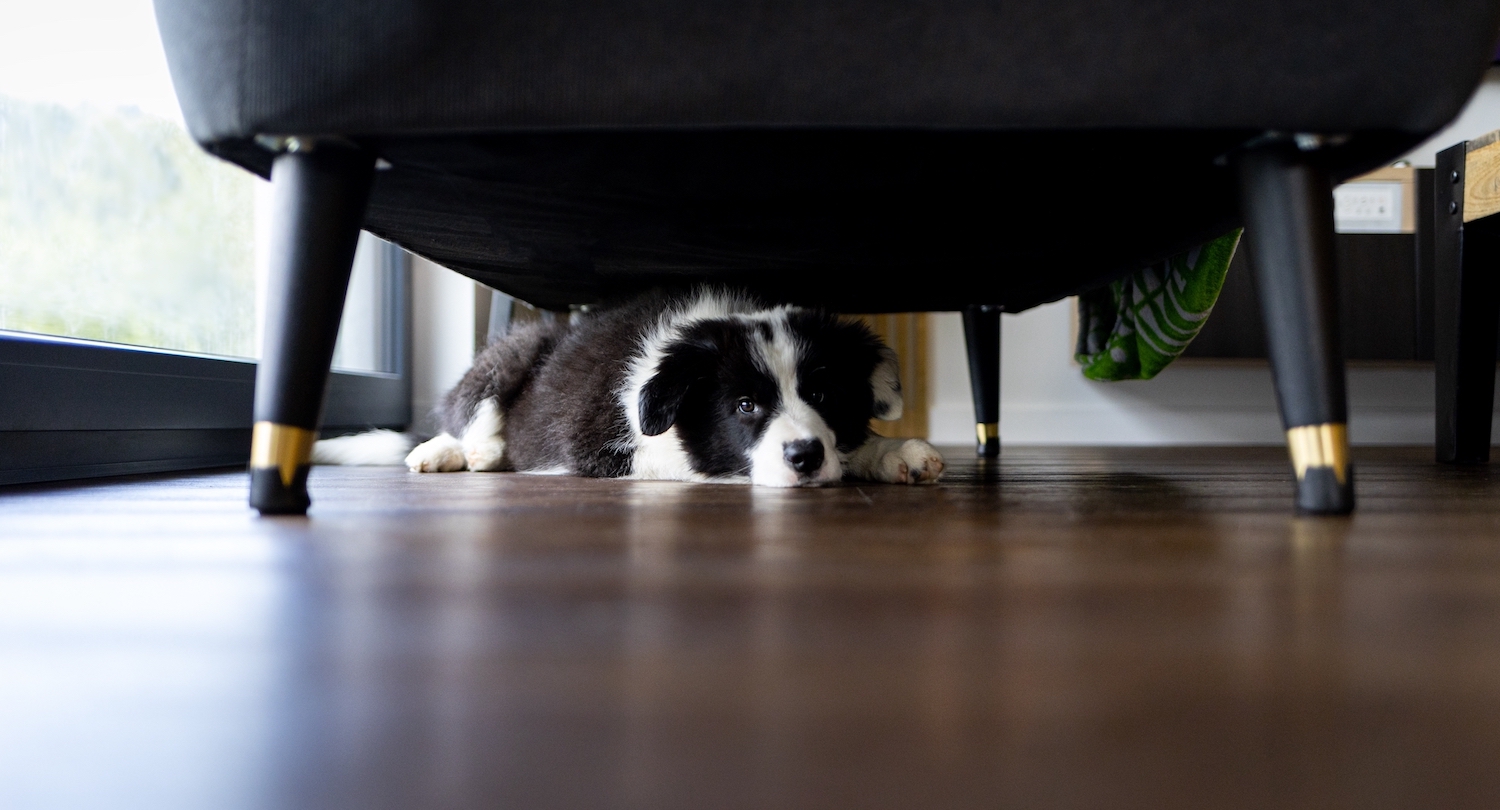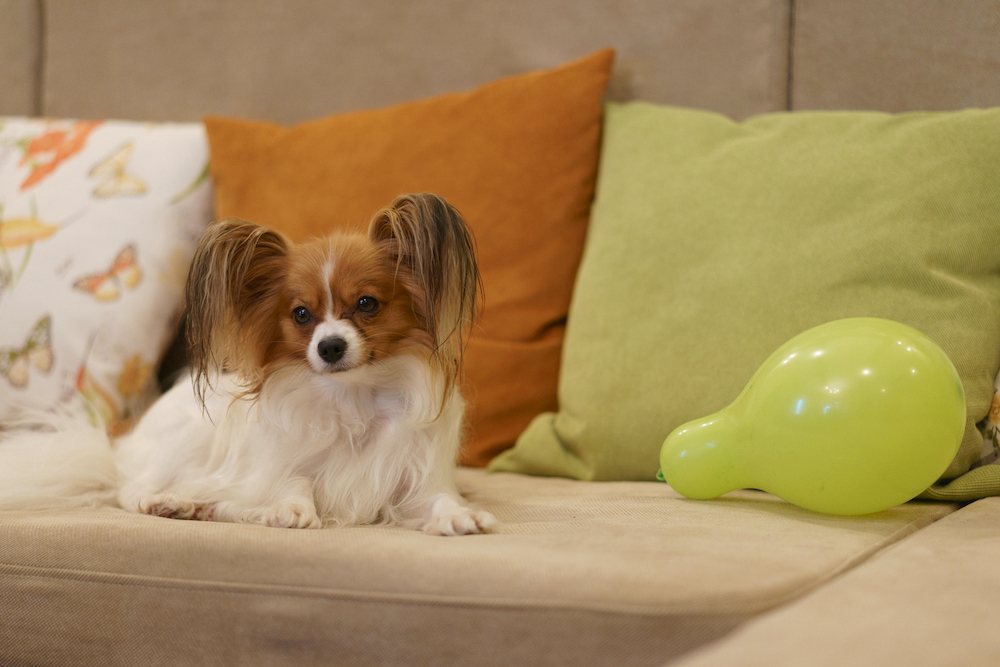The Farmer’s Dog customer TH asks: “How can I cure my dog from being terrified of balloons?”
Dear TH:
It can take patience to help a dog get over a fear of something like balloons, but there are ways to do it—even if you live next door to a kids’ birthday-party venue or a residential community for clowns. Here’s some advice that might help.
Learn how to use desensitization and counterconditioning
The best tools available for helping a dog conquer a fear are desensitization and counterconditioning. You’ll often hear those two words together. In her book Wag: The Science of Making Your Dog Happy, Dr. Zazie Todd explains them this way:
“Desensitization means presenting the stimulus at a very low level that the dog is happy with, and gradually increasing it so the dog becomes used to it (the opposite of sensitization). In counterconditioning, every single presentation of the stimulus is followed by something the dog likes (such as chicken or cheese) so the dog learns the stimulus predicts good stuff happening.”
These methods can apply to anything if you can control the level of the stimulus—in this case, balloons—and the reward your dog receives in their presence.

First, try to figure out what is bothering your dog about the balloons. “Is it balloons because they’re moving outside?”, asks Denise Herman, founder and head trainer at Empire of the Dog in New York City—“Is it balloons anywhere? Is it helium balloons? Is it deflated balloons?” Once you figure out what about balloons scares your dog—the way they move, their appearance, their sound, or anything else about them—you can try to expose your dog to a low level of that stimulus and pair it with rewards.
Desensitization would involve having the balloon in the dog’s presence at an intensity that doesn’t bother them, and counterconditioning would involve giving your dog something they love in the presence of the balloon to help them learn that, when balloons are around, good things happen.
For this to work correctly, your dog has to notice the balloon but still be able to remain calm. If your dog is freaking out, the thing that’s bothering them is too intense, and you need to turn it down—whether that means making it less noisy, smaller, or further away. Don’t put your dog near a dozen balloons that lead to panting, barking, and desperate attempts to escape, and think that you’ll help them by tossing a few treats their way.
“Maybe you start by blowing a balloon up to the least ‘balloon’ look you can,” Herman suggests. “Maybe it’s only two inches, and tied off… And then you can start to do things like have the balloon passively hang out in the house, just sitting on a sofa or sitting on the floor, or maybe you tie it somewhere and let it dangle, depending on where the dog notices it but isn’t terrified of it.”
When a dog can notice the stimulus, but not be afraid of it, they’re “under threshold.” It is in this state that they can learn to get over their fear.
Maddie Messina, applied animal behaviorist and founder of Paws for Thought Dog Training in New York City, says that keeping the intensity of the stimulus low is key to helping a dog learn. “The main reason why you want to work with a dog being under threshold,” she says, “is that they’re still able to analyze stimuli that are coming into their brain and decide that they are safe or not safe appropriately—because once they’re over threshold, that thinking part of their brain is not really doing the majority of the work anymore. We need them to be cognizant of, ‘Oh, wait a minute, that thing that used to be scary to me—at this distance or intensity—it’s not that scary at this point.’”
So if your dog does want to escape the balloon, as long as they’re not running toward danger, let them retreat. Forcing a dog to stay in the presence of something they’re afraid of can make their fear worse and harder to overcome.
Once you find a level of the stimulus where your dog is calm, you can bring in rewards. When you use treats for counterconditioning, your dog only has to notice the stimulus and remain calm enough to take the reward. You shouldn’t require them to do anything beyond this, although once your dog is doing well you may want to see if they can play and perform tricks anyway. If they can, you’re on the right track.

Listen to what your dog tells you
Reading your dog’s body language is an important part of helping them get over a fear. If your dog is exhibiting signs that they’re afraid—panting, showing “whale eye,” tucking their tail or trying to escape—help them get away so that they know they’re not cornered.
On the other hand, if your dog is showing you that they’re calm, you can try to get them more involved.
“You gauge your dog’s comfort level by their body language,” says Herman, “My dog used to really hate the sound of children. And skateboards, too. And I could tell we were making headway when I didn’t have to just give her food—when she was relaxed enough to eat the food and I could say ‘spin, spin,’ and she could do her tricks and then I would pay her with food.”
Don’t keep your dog near the balloon if they don’t want to be there, even by giving them “sit” and “stay” commands as they try to retreat. Herman calls that “psychological warfare.”
If you encounter a balloon outside and your dog wants to skip town, Herman says to “run with them in the direction they want to go, if it’s safe—because they’re going to recover faster so it doesn’t become a huge firestorm. Then you can chip away at [the fear] later, or you can control it.”
Put out positive vibes
While you should protect your dog from what scares them, you can still sound optimistic about it. Try your best not to act as if you, yourself, are afraid of balloons.
When a dog encounters something they don’t like, Herman says, she goes into what she calls “the jolly routine.” She explains that it’s a little bit like how parents remain calm and positive when children fall and skin their knees. “You kind of reset the moment a little bit,” she says. “‘Oh my gosh, what’s that?’ Do your high-pitched biscuit voice. And you can say nonsense words. It doesn’t even matter. Because your dog’s reading the room.”
Be patient
You’re unlikely to get instant results, and shouldn’t believe anyone who tells you that they can guarantee them.
“We’re not usually talking about a matter of minutes or days,” Herman says of the timeline for overcoming a fear—balloon-based or otherwise—“unless the dog is a super-young puppy under three months. Four months or older, you’re typically talking days to a month or more depending on how well you control the narrative. You know, how much you can avoid the other ‘bad’ balloons and how much plasticity your dog has as an individual. It’s like going to a shrink and asking: ‘how long is it going to take you to cure me?’”
On the bright side, Herman says that the longer you keep at desensitization and counterconditioning, the better your dog is likely to get. “It’s not like obedience training,” she says. “If you do everything right, [desensitization and counterconditioning] gets faster and better the longer you’re doing it—versus the way other training looks amazing when you first start, and then the gains that you make—like, ‘sit’ doesn’t get exponentially better the longer you do it. You see the first big gains in the first week or two, and you’re like, ‘My dog is amazing! He’s sitting all the time now.’ A year later, people aren’t like, ‘My dog is sitting better than he ever has…’ When you’re talking about emotional stuff, you’re more successful the longer you stick to it.”
Comfort your dog if they want it, but don’t stop there
If your dog does encounter balloons that they find scary, and comes to you for comfort, go ahead and pet them and tell them everything’s okay. “Comforting them is never going to make fear worse,” Herman says, “Unless you’re also doing something that is forcing them to be in the situation when you really should have left it.” So don’t cuddle your dog and hold him close to the balloons if they’re bothering him—let him get away from them. But if he runs to you for affection when he’s scared, you can give him some belly rubs or whatever it is he likes. Although you shouldn’t reinforce undesirable behavior, fear is not a behavior—it’s an emotion, and you won’t get more of it if you acknowledge it.
Having said that, Herman recommends making sure you don’t just comfort your dog and call it a day. “You’re going to get more traction bringing out heavier good artillery,” she says. “So that your dog isn’t on your lap, but they’re still, like, ‘Oh my God, the thing is so scary.’ So I can say ‘What thing? Look at this!’ And throw some treats, or get a favorite toy, or moderate the threshold that the scary thing is at.’”
Socialize your puppy
If your dog’s already afraid of balloons, the above techniques are a good place to start. But if you have a puppy who hasn’t developed fears, you can take steps to try to prevent them from arising in the first place via socialization.
Herman has a routine for this as it relates specifically to balloons. “When I would do puppy class,” she says, “I would blow up a balloon. And when I take care of dogs, I play with them and get them used to balloons. But we under-inflate them, because you certainly don’t want to blow up a big balloon, and your dog gets comfortable with it, and it pops.” That’s one of the keys to this type of exposure—you want your dog’s early experiences with the stimulus to be positive so that they can build up a record of safe, happy memories around it.
Don’t be afraid to ask for help
Don’t let the balloon situation blow up larger and larger until it pops. If you feel that you’re stuck—your dog is miserable, behaving in ways that are dangerous to themselves or others, or simply not improving—call in a qualified, responsible professional who can help you diagnose and address the problem. Their methods should be some version of what’s outlined above, and they shouldn’t promise instantaneous results, but it’s often helpful to have an expert’s perspective and guidance.
“Emotionally,” Herman says of dogs whose fears aren’t improving, “there’s a hole being dug. How deep do you want it to get before you start trying to dig yourself out of it?”









